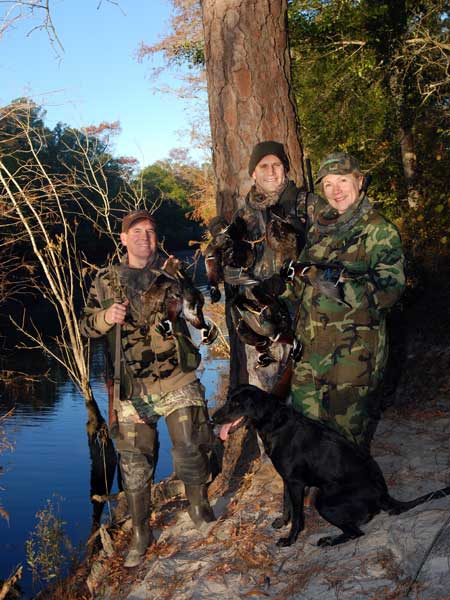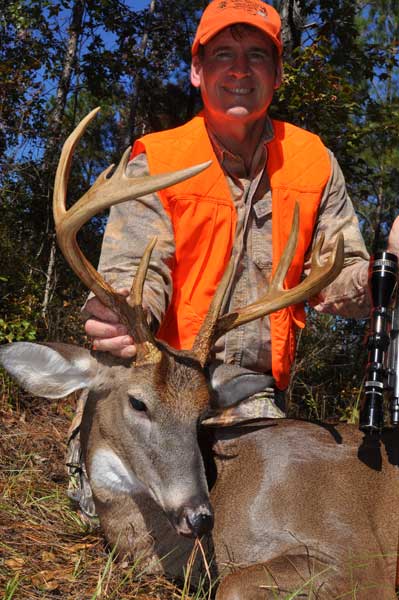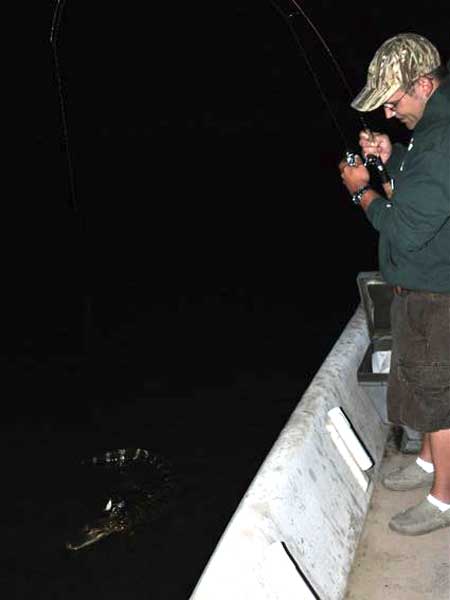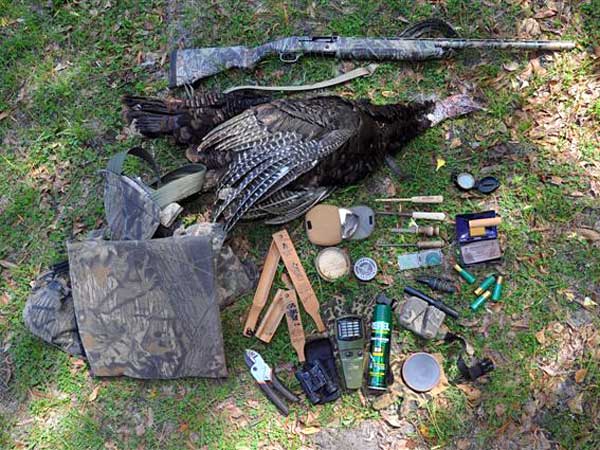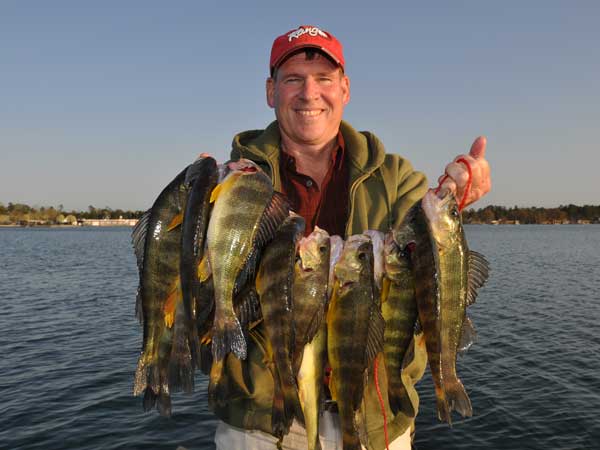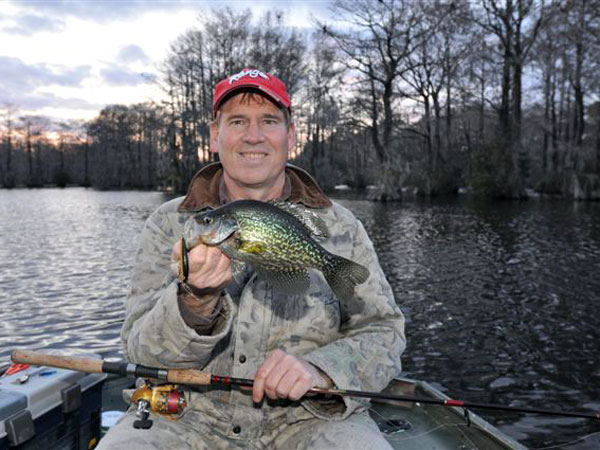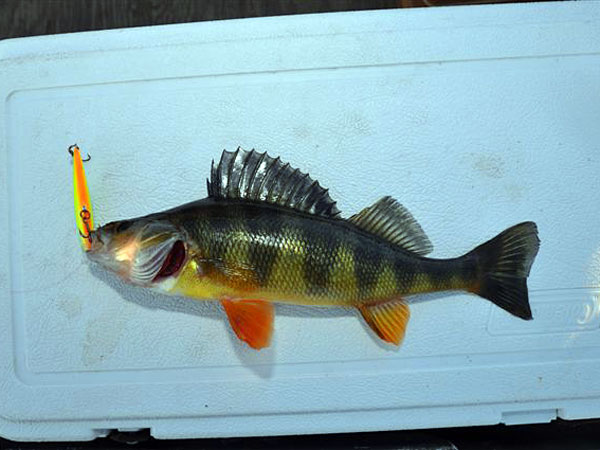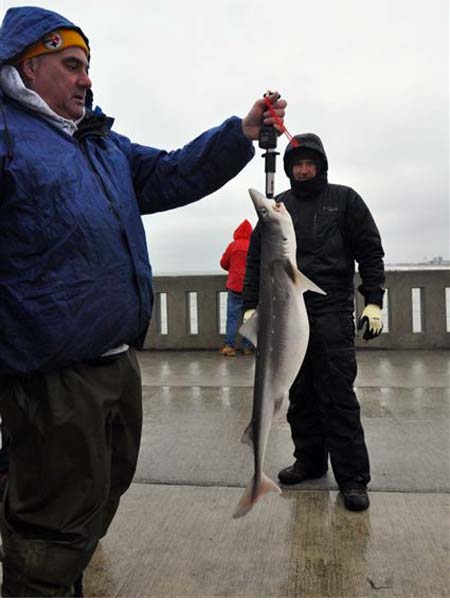- Details
- Written by Mike Marsh
Carol, Justin and I headed for our woods on opening day of duck season. There were plenty of wood ducks feeding on the acorns in flooded timber. The acorn drop was exceptional this year, making it two years in a row. It is unusual for oaks to bear strongly two years in a row.
We shot some inexpensive Winchester ammo, a 1 1/8-ounce load of No. 4 steel at a velocity of 1550 fps. The lighter load at higher velocity was perfect. Tink, our Labrador retriever, only had to dig one cripple out of a windrow and a fine job she did. She chased it into the open where we all could watch.
Next hunting day wasn't as good for our young dog. Two woodies hit the water five minutes before legal shooting time. As I watched my watch, she could no longer stand it and tried, futilely to catch an unshot duck!
Well, hunters make mistakes, too. She probably gets disgusted when I miss a shot. I would rather have one that can't keep her control than one that has to be prodded out of the blind to make a retrieve. By the third duck of the morning, she was steady again and had regained her composure. I wonder if, when I looked at my watch, she took it as a silent hand signal to make the retrieve. It is possible because any voice sound or hand movement can set a high-strung dog on a retrieve.
- Details
- Written by Mike Marsh
A Missed Shot Leads to a Better Opportunity
by Mike Marsh
Like most hunters, when I miss a shot, I want to make sure that it was indeed a miss. On opening day, I missed a coyote, but the missed opportunity led to a trophy buck.
On opening day of the eastern region gun season, I had seen two does and a spike buck. But having taken two deer with a muzzleloader the previous week, there was no hurry to take another meat deer.
At 9:00 a.m. an animal appeared 150 yards distant. Thinking at first it was a deer, I was in no hurry to raise my Remington 700 .30-06-caliber bolt-action rifle. Then it appeared to be a dog, perhaps a fox.
It turned out to be a coyote. I had seen coyote tracks in wet ground as floodwaters generated by tropical storm Nicole receded.
Coyotes are seldom motionless and this one was no exception. The wind was blowing, swaying my tree stand. I lead the critter as it scurried along. When I took the shot at 230 yards, the coyote suddenly stopped. The crosshairs were too far in front so the bullet missed.
I climbed down and found the bullet strike and tracks of the fleeing canine. Had I taken the coyote, I would have called my wife, Carol, for a photo session. She was hunting another stand 250 yards away and we exchanged text messages about the event, which she initiated when she heard the shot.
Returning to the stand, I replayed the events, aligning the crosshairs on the point of the bullet strike. I lowered the seat to provide more height for steadying the rifle across the stand’s shooting rest, adjusted the scope’s ocular lens for better clarity and reset the parallax adjustment.
At 9:50 a.m. according to Carol’s next text message, I was presented with another opportunity. A doe stepped out of the woods where the coyote had run away. I aligned the rifle, which was still unsteady because of the wind swaying the stand.
The doe glanced over her shoulder as she slipped into the woods on the other side. A buck took a couple of steps, sniffing the spot where she had been standing. The buck's antlers were massive enough to show the buck was a trophy to the naked eye even at 230 yards. Since I had just scoped out the doe and declined to shoot, the rifle was still on the shooting rest. I had only to re-cheek the stock, align the crosshairs and touch the trigger. Had I not been so well prepared, the buck would have followed the doe out of sight. But the 150-grain Hornady bullet dropped the buck instantly when it struck the deer right behind the shoulders.
Had he been the coyote, I might have missed. Had I hit the coyote, Carol would have come to help with photos and the doe and buck would have been spooked away. The buck fell on the exact spot the bullet struck after missing the coyote. It’s amazing how a chain of events, including a miss that had me second-guessing moments before, can lead to taking a 10-point buck.
- Details
- Written by Mike Marsh
The full moon was so inviting that Justin and I headed out for a night-fishing expedition. The cool quietness of the night was wonderful and our efforts were rewarded with a 3.9-pound speckled trout and one alligator!
The 3--foot alligator put up quite a struggle, but we eventually got Justin's jig free from its leg and released it unharmed.
We don't know whether the alligator was striking the lure or if the line simply dragged across the beast until the jig struck home. It wasn't until I had the net out and switched on a light that we realized it wasn't a shark or big redfish.
- Details
- Written by Mike Marsh
The bluefish have arrived along the N.C. Coast. Big choppers showed up right on time, with fish in the 7 to 10-pound range at the southern coast inlets.
The best bet for the big choppers is a live menhaden or mullet fished on a treble hook rig, with a float or a Carolina rig. Hook the menhaden near the tail at the anal fin. Otherwise, all you may reel back in is the head of the menhaden. Be sure to use a wire leader.
Big blues are also suckers for Hopkins spoons and topwater poppers. A big Zara Spook is another good bet for attracting one of the most savage topwater strikes you've ever experienced.
Look for the birds feeding on baitfish the bluefish run to the surface. Usually, bluefish will be churning the water and leaving an oil slick from the chopped up baitfish.
- Details
- Written by Mike Marsh
Turkey vests are too big. It seems the more I hunt turkeys, the more gear I need to carry. My dedicated turkey vest must weigh 20 pounds! I shot my first turkey using nothing more than an Olt scratch box call that weighed an ounce. I put the call in one shirt pocket and the striker in the other while I was walking the N.C. Mountains to keep them quiet. All I had was a gun, face net and gloves and milspec surplus camo pants, cap and shirt. It was in the 1970s and turkey season had just reopened. Don't we turkey hunters love our gadgets and gear?
In my vest on this year's N.C. opening day were:
- Padded seat, with an extra cushion because the ground gets harder the older I get
- Friction calls, with multiple strikers
- Box calls
- Box call kit with sandpaper, chalk, rubber bands, etc.
- Super Yelper scratch box call in soap travel case
- Compass (or GPS)
- Pruning shear
- Shotgun ammo
- Owl call
- Crow call
- Gloves
- Face net
The noisiest items that must be quieted in my vest while walking are the diaphram call box (it has original packaging that can be quieted with tape on the outside and a piece of paper towel on the inside but I've been too busy hunting to even think about it until now), ThermaCell insect repellent device and plastic refill packages, and aerosol insect repellent.
Not shown is the paper towel emergency paper, which I had to use. "Nature paper" can also be used to silence calls and gear by filling a pocket until it is needed.
My paddle style box calls are silenced by inserting a business card between the lid and the soundboard sides, with a tear in each side of the card. A rubber band or hair band goes around the call and into the slots torn into the business card to keep it from slipping from between the bearing surfaces. If I lose the call in the woods, hopefully someone will read the business card and make arrangements to return the call. On large boat paddle calls or collector calls, I put a green army surplus sock around them to keep them quiet and protect the finish.
Box calls go into the "game pocket" compartment at the rear of the vest, along with insect repellent, ThermaCell device, and water bottle.
I switch calls nearly every day, keeping spare box calls in the vehicle with a sock around them.
Notice the aluminum friction call inside a padded call case. The padded case keeps the metal surface quiet. I also carry a slate and a glass call, which fit into individual pockets on the inside of the vest.
Another tip is using camo duct tape to silence the plastic or metal buckles and fittings on the vest. I put the clip/buckle that goes around my waist into a pocket to keep it from banging, but I really should just cut it off since I don't use it.
Sometimes I carry a telescoping blind or fold up blind, which can fits into the game pocket and can bang around against buckles. Then there's Henrietta, a real hen mounted by a taxidermist that fits in a plastic storage bin painted in a camouflage. The plastic bin is very noisy, rubbing against twigs and buckles.
They say you can't sneak up on a turkey. No wonder, if you're wearing a vest like mine, with all this stuff stuffed inside it.
Turkey season has been excellent. Carol missed one and got one. I missed one and killed one in N.C. and one in S.C. You can read more in the Goldsboro News Argus Friday Sports page on Apr. 23, or in future Wilmington Sunday Star News. www.newsargus.com and www.starnewsonline.com.
Or check out my Facebook page.
Good hunting.
Mike
- Details
- Written by Mike Marsh
Fishing for Yellow Perch at White Lake
Yellow perch fishing was excellent during the full moon. These yellow perch came from White Lake and several topped the NCARP minimum weight of 1 pound. The trick for catching the big ones is trolling in the deep water, not casting along the banks. Use perch patterns because yellow perch are cannibalistic, forming the base of their own food chain.
Early Spring Bass Fishing
Testing the coastal lakes for an early bass bite resulted in this largemouth, which I hooked at Lake Waccamaw. It was a bit windy, so I fished the calmer side of the lake. The bass were hitting small spinnerbaits and soft plastics in the grass beds and Capt. Butch Foster and I hooked about a dozen of them. We also caught one shellcracker and some small white perch.
Cold weather is not bad weather for fishing.
Cold weather is not bad weather for fishing. Lakes in the coastal plain are hosting some excellent fishing.
Among the best fish to catch this time of year are black crappie and yellow perch. These great tasting fish are common in waters the color of tea and hit the same types of lures. Spinnerbaits, jigs, spoons and small crankbaits are best. But these fish will also strike live minnows and red worms.
Don't stay home. Head for the rivers, creeks and lakes for these fish. Good lakes to try included Baytree, Greenfield, White, Waccamaw. Great fishing is going on right now in all the rivers. The water is falling so the fishing is on the rise.
- Details
- Written by Mike Marsh
Al Baird of the North Carolina Public Access Foundation, Inc and North Carolina Fishing Pier Society weighs a dogfish caught by Justin Trujillo. Justin caught more dogfish than any other angler in the NCPFS Dogfish Tournament held at Johnnie Mercer's pier in Wrightsville Beach, NC. The tournament grows each year, with anglers coming from Ohio, Pennsylvania and many inland areas to participate in the first saltwater tournament of the year.
Sixty-six anglers braved freezing conditions to compete in the all-release tournament. At least two dogfish broke the previous tournament record.
It all began with a few anglers sitting in the pierhouse watching the Super Bowl. They wanted to get a tournament going to help keep anglers interested and just plain do something to get out of the house. The only fish biting were dogfish, sooooooo.
A few clearnose skates are usually landed along with spiny and smooth dogfish.
Copyright Notice
Any use of images and/or content of this website without a license agreement issued by Michael S. Marsh is strictly prohibited.

